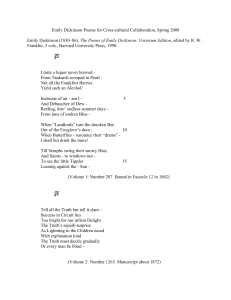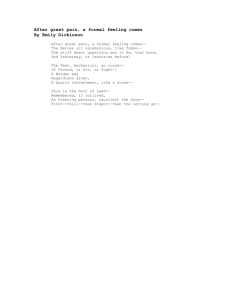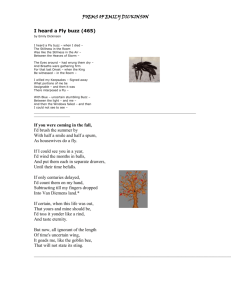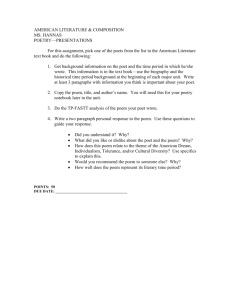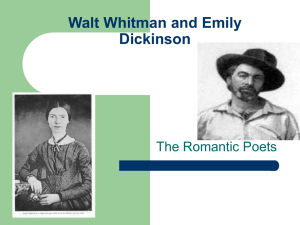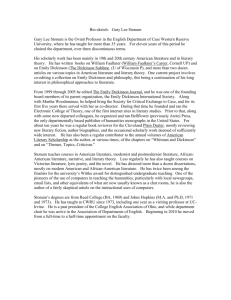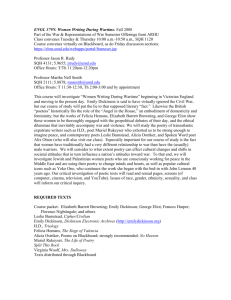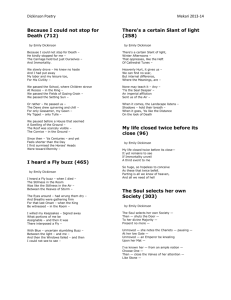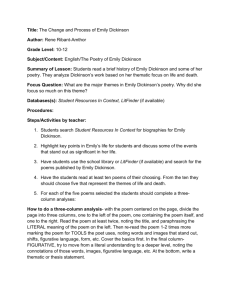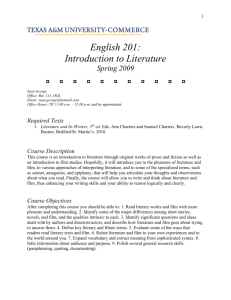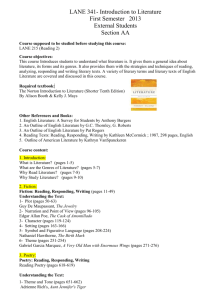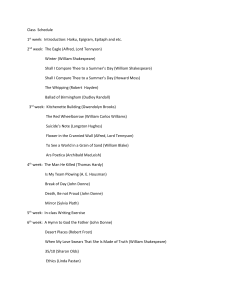English Composition 102
advertisement
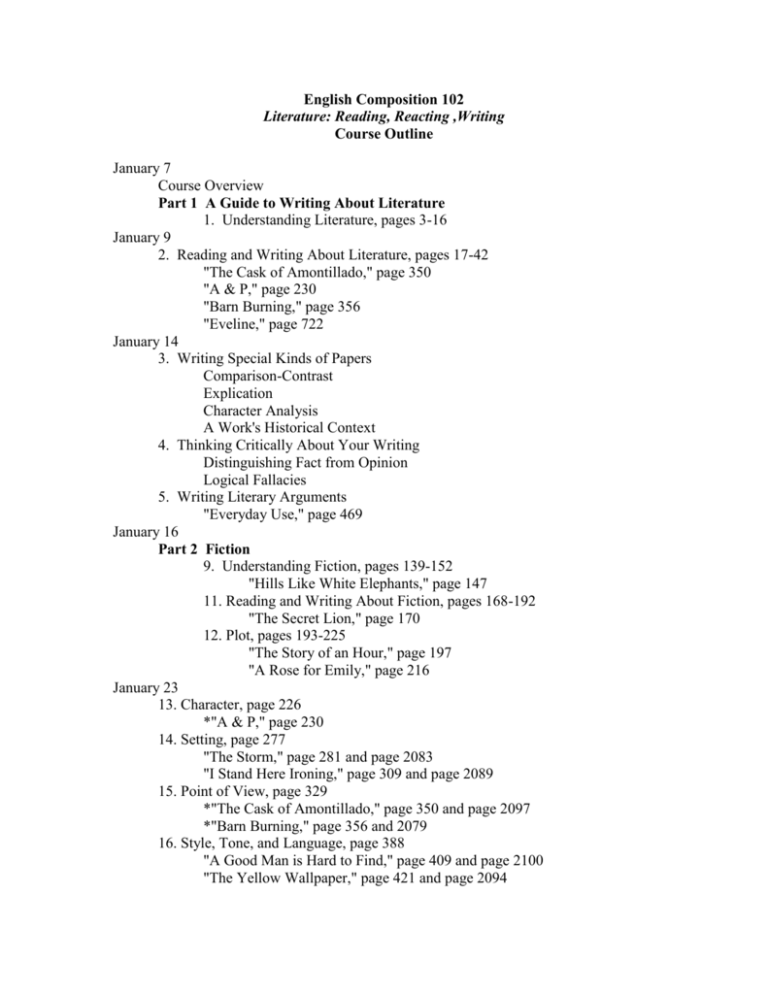
English Composition 102 Literature: Reading, Reacting ,Writing Course Outline January 7 Course Overview Part 1 A Guide to Writing About Literature 1. Understanding Literature, pages 3-16 January 9 2. Reading and Writing About Literature, pages 17-42 "The Cask of Amontillado," page 350 "A & P," page 230 "Barn Burning," page 356 "Eveline," page 722 January 14 3. Writing Special Kinds of Papers Comparison-Contrast Explication Character Analysis A Work's Historical Context 4. Thinking Critically About Your Writing Distinguishing Fact from Opinion Logical Fallacies 5. Writing Literary Arguments "Everyday Use," page 469 January 16 Part 2 Fiction 9. Understanding Fiction, pages 139-152 "Hills Like White Elephants," page 147 11. Reading and Writing About Fiction, pages 168-192 "The Secret Lion," page 170 12. Plot, pages 193-225 "The Story of an Hour," page 197 "A Rose for Emily," page 216 January 23 13. Character, page 226 *"A & P," page 230 14. Setting, page 277 "The Storm," page 281 and page 2083 "I Stand Here Ironing," page 309 and page 2089 15. Point of View, page 329 *"The Cask of Amontillado," page 350 and page 2097 *"Barn Burning," page 356 and 2079 16. Style, Tone, and Language, page 388 "A Good Man is Hard to Find," page 409 and page 2100 "The Yellow Wallpaper," page 421 and page 2094 January 28 17. Symbol, Allegory, and Myth, page 450 "The Lottery," page 461 *"Everyday Use," page 469 18. Theme, page 500 "A Worn Path," page 505 January 30 20. Joyce Carol Oates's "Where Are You Going, Where Have You Been?" A Casebook for Reading, Research, and Writing, Pages 570-617 21. Fiction for Further Reading "The Lady with the Pet Dog," page 673 February 4 "Bartleby the Scrivener," page 731 "Everything That Rises Must Converge," page 762 "The Jilting of Granny Weatherall," page 777 "The Chrysanthemums," page 783 February 6 Test February 11 Essay February 13 and 20 Writing a Research Paper, page 96 Eudora Welty's "A Worn Path," page 106 and pate 505 Documenting Sources and Avoiding Plagiarism, page 113 February 25 and 27 Part 3 Poetry 22. Understanding Poetry Selected Works 24. Reading and Writing About Poetry Robert Hayden's "Those Winter Sundays," page 831 Seamus Heaney's "Digging," page 832 25. Voice Emily Dickinson's "I'm nobody! Who are you?" page 851 Robert Browning's "My Last Duchess," page 856 Thomas Hardy's "The Man He Killed," page 865 William Wordsworth's "The world Is Too Much with Us," page 870 Robert Herrick's "To the Virgins, to Make Much of Time," page 873 W.H. Auden's "The Unknown Citizen," page 881 26. Word choice, Word Order A.E. Housman's "To an Athlete Dying Young," page 916 Emily Dickinson's My Life had stood—a Loaded Gun," page 917 27. Imagery William Shakespeare's "My mistress' eyes are nothing like the sun," page 933 Other Selected Works 28. Figures of Speech Simile, Metaphor, and Personification John Updike's "Ex-Basketball Player," page 946 John Donne's "A Valediction: Forbidding Mourning," page 949 Hyperbole and Understatement Sylvia Plath's "Daddy," page 952 Andrew Marvell's 'To His Coy Mistress, page 957 Metonymy and Synecdoche Apostrophe March 3 and 5 29. Sound Rhythm Meter Emily Dickinson's "I like to see it lap the Miles--." Page 974 Adrienne Rich's "Aunt Jennifer's Tigers," page 977 Alliteration and Assonance Robert Herrick's "Delight in Disorder," page 982 Alliteration, Assonance, and Rhyme Lewis Carroll's "Jabberwocky," page 993 30. Form Closed Form Blank Verse Stanza The Sonnet The Sestina Theodore Roethke's "The Waking." Page 1008 The Villanelle Haiku Selected Works Open Form Carl Sandberg's "Chicago," page 1016 Walt Whitman's from "Out of the Cradle Endlessly Rocking," page 1018 31. Symbol, Allegory, Allusion, Myth Selected Works March 10 and 12 32. Discovering Themes in Poetry "Theodore Roethke's "My Papa's Waltz," page 1058 Robert Hayden's, "Those Winter Sunday's," page 1059 Seamus Heaney's "Digging," 1060 Dylan Thomas's "Do not go gentle into that good night," page 1065 Other Selected Works 34. Poetry for Further Reading Matthew Arnold's "Dover Beach," page 1141 William Blake's "The Chimney Sweeper," page 1144 Samuel Taylor Coleridge's "Kubla Khan," page 1153 E.E. Cummings' "Buffalo Bill's," page 1158 Emily Dickinson's "Because I could not stop for Death--," page 1160 Emily Dickinson's "I heard a Fly buzz—when I died--," page 1161 Emily Dickinson's "Some keep the Sabbath going to Church--," page 1165 John Keats' "Ode on a Grecian Urn," page 1193 Christopher Marlowe's "The Passionate Shepherd to His Love," page 1202 Sylvia Plath's "Mirror," page 1214 Sir Walter Raleigh's "The Nymph's Reply to the Shepherd," page 1216 Edwin Arlington Robinson's "Miniver Cheevy," page 1217 Edwin Arlington Robinson's "Richard Cory," page 1218 March 24 Test March 26 Essay March 31 Part 4 Drama 36. Understanding Drama Anton Chekhov's "The Brute," page 1293 April 2 38. Reading and Writing about Drama Susan Glaspell's Trifles, page 1371 April 7 39. Plot Henrik Ibsen's A Doll House, page 1453 April 9 Research Paper April 14 40. Character 41. Staging 42. Theme Sophocles' Antigone, page 1899 April 21 43. Tennessee Williams's The Glass Menagerie: A Casebook for reading, Research, and Writing, page 1994 April 23 Test Journal April 28 Makeup Final Exams April 30 at 5:30 for the 5:30 Class May 5 at 6:30 for the 7:00 Class Journal Journal entries should be made for a minimum of one literary work per class day. The journal must contain evidence of reading on the part of the student and the student's reactions to the readings. All entries must adhere to the forms of good composition and must be of sufficient length to intelligently discuss the works of choice. The instructor will determine the quality and sufficiency of the entries. All assignments must be completed on the instructor's timetable. Failure to complete an assignment on time will result in a deduction of ten points per class day the assignment is late. The instructor will determine whether an absence is excused or not. The course outline is subject to change at the instructor's discretion.
